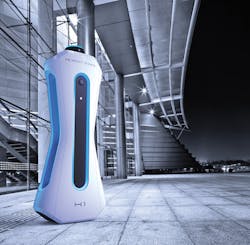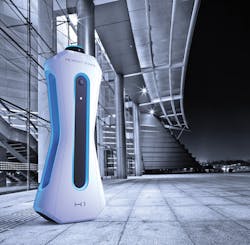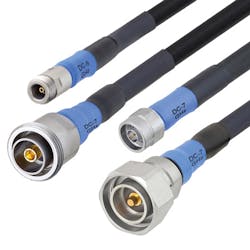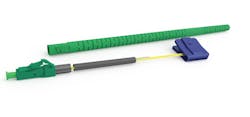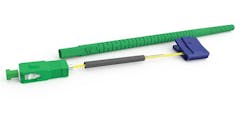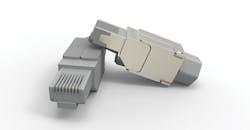News, products and trends for the communications systems industry
PHYSICAL SECURITY
Knightscope’s stationary K1 physical security scanner uses Machine-as-a-Service model to detect concealed weapons, radiation
Knightscope, a developer of physical security technologies focused on “significantly enhancing U.S. security operations” has announced its K1 platform, as a stationary complement to the company’s existing portfolio of mobile Autonomous Data Machines (ADM), including the K3 (indoors), K5 (outdoors) and the upcoming K7 (multi-terrain). The K1 will initially cater to airports, hospitals, retail and other environments with highly sensitive points of ingress/egress requiring a physical presence but in a stationary form.
Knightscope will begin delivering the K1 to clients in the fourth quarter of 2017 with a comparable set of features to that of its K3 and K5 platforms, but priced at $5 per hour for both indoor and outdoor usage.
These features include 360-degree daytime/nighttime live streaming and recorded video, license plate recognition, people and signal detection as well as broadcast and intercom functionality. The K1 with the optional Concealed Weapon Detection and Radiation Detection capabilities will commence shipping in 2018 at $7 per hour utilizing Knightscope’s Machine-as-a-Service (MaaS) business model. Clients electing not to utilize these optional features will still be able to obtain the K1 at the $5 per hour rate in 2018.
“We are determined to make the United States of America the safest country in the world, changing everything for everyone,” said William Santana Li, chairman and chief executive officer, Knightscope, Inc. “To achieve such an audacious goal, we will need to employ a vast portfolio of technologies to provide security and law enforcement professionals unprecedented capabilities to help keep everyone safe.”
INTERNET OF THINGS
BSNL, Coriant form pact to bring 5G and IoT technologies to India
On Sept. 6 in New Delhi, India’s leading telecom operator, Bharat Sanchar Nigam Limited (BSNL), announced that it entered into an agreement with end-to-end, multi-layer transport networking/SDN specialist Coriant to chart a path to 5G and Internet of Things (IoT) in India.
Per a press statement, “A memorandum of understanding was signed between BSNL and Coriant for laying the foundation for innovation in network architectures and services leveraging 5G, IoT, SDN/NFV, and mobile edge computing technologies.”
As part of its strategic collaboration, BSNL and Coriant say the companies “will work together to develop 5G and IoT use cases such as rural connectivity, connected healthcare, industrial automation, public safety, video surveillance, energy, and agriculture.
“In addition, the agreement encompasses research programs, knowledge sharing, and workshops focused on the latest networking trends and hyperscale architectures designed to support the scalable, ultra-low latency, ultra-efficient, and reliable delivery of commercial 5G services and applications,” added the statement.
“We continue to focus on bringing our customers across India the latest innovations in communications technologies that enrich their personal and work lives,” said Shri Anupam Shrivastava, CMD at BSNL. “5G represents an enormous leap forward in capacity and throughput speeds, and we are pleased to team with our long-term technology partner Coriant to tap into these capabilities and explore real-world use cases for next-generation services and applications.”
Per the companies, “5G is a fifth-generation wireless technology that promises significant advances in transmission speed, quality, and resiliency compared to current mobile technologies. Capable of transforming media consumption and content delivery for end-users, 5G will impact diverse market segments and applications in the India telecommunications market.”
“BSNL’s vision aligns nicely with our strategy of driving innovation in purpose-built 5G solutions and architectures,” said Shaygan Kheradpir, CEO and chairman, Coriant. “We look forward to our joint work and the opportunity to help BSNL fast track development toward a 5G and IoT future and bring the value of these technologies to India and its citizens.”
TEST EQUIPMENT
Pasternack aims handheld RF analyzer phase-stable cable assemblies at tower technicians, field maintenance crews
Pasternack has launched a new series of handheld, RF analyzer, rugged, phase-stable cable assemblies. According to the company, typical applications may include field testing, tower measurements, base station analyzers, handheld network analyzers, portable spectrum analyzers, distance-to-fault measurements and site maintenance.
The new line of test cables for handheld RF analyzers consists of 19 models designed to deliver optimal amplitude and phase stability with flexure. Cables are offered with 7/16, N, SMA, TNC or 3.5mm connector options and each serialized assembly includes test data. They can be used as replacement cables for the FieldFox, Site Master, CellAdvisor and Sitehawk brand handheld analyzers.
The rugged test cables boast VSWR as low as 1.2:1 and a maximum operating frequency of 27 GHz, depending on configuration. The cables feature crush resistance of 1200 psi and operating temperature range of -55°C to +105°C. They are made with silver-plated copper cable conductors, stainless steel-body connectors, a UV-resistant jacket and a rugged, multi-layer armor for crush and torque resistance.
INSTALLATION PRODUCTS
Wirewerks unveils LC and SC fiber splice-on connectors, plus field-terminable RJ45 plug for shielded/unshielded Cat 6A
Network infrastructure specialist Wirewerks recently announced the launch of its Optical Fiber Splice-On Connector product line. The Wirewerks Fiber Splice-On connectors are compatible with any 2-3mm OD single fiber cable and are available in LC and SC connector formats in either APC or UPC ferrule polishing styles. The new fiber splice-on connectors combine the performance and reliability advantages of fusion splicing with the flexibility and on-site termination benefits of field-installable connectors, states the company.
Per a press release, “Each Splice-On Connector is pre-assembled with no housing to install and pre-cleaved so that technicians only prep and splice the incoming fiber. The ultra-flexible boot allows routing even in tight spaces and provides a labeling space for proper fiber identification. Wirewerks Splice-On Connectors are compatible with any fusion splicer and eliminate the need for expensive crimping tools, splicer jigs, index matching gels, and splice trays/enclosures; providing cost effective, reliable, low-loss solutions for fusion-spliced field fiber termination.”
Edouard Tabet, Wirewerks’ head of engineering, commented, “The ease-of-use and high yield, high-performance results of our innovative new fusion splice-on connector will be beneficial in a broad variety of optical network applications, including LANs/SANs/WANs, data centers, carrier telecom networks, CATV networks, cell tower base stations, FTTx networks, and test and measurement systems.”
Separately, Wirewerks also announced the launch of its Field Terminable RJ45 Plug product. The new RJ45 plug combines the performance and reliability advantages of factory-terminated Category 6A plugs with the flexibility and on-site termination benefits of field-installable connectors, contends the company.
Wirewerks’ Tabet commented, “Our new field terminable RJ45 plug is beneficial in any application where the required cable length is unknown. The plug also provides a simple, reliable solution for attaching IP-enabled devices to the network, including cameras and more. And the plug’s factory-equivalent terminated performance means that it can be used with complete confidence to solve the problems and delays caused by over/under-length cable runs in pre-terminated cabling systems.”
Per a company press statement: “Available in both shielded and unshielded formats, the Wirewerks Field Terminable RJ45 Plug enables fast, reliable on-site termination of UTP and FTP solid-conductor copper cables in the exact lengths required for each individual cable run. Cable pairs are precision terminated on an IDC module within the plug, and the cable itself is secured to the plug by simply closing the plug’s two hinged jaws and locking with the integrated compression nut.”
DATA CENTERS
Lumos Networks appoints new sales director for data center business
Lumos Networks Corp., a fiber-based data center service provider in the U.S. Mid-Atlantic region, announced Michael Creech as director of sales for the company’s recently created Lumos Data Center business. Creech will report to Josh Wolff, senior vice president for Lumos Data Centers; both will be based in Charlotte, NC.
Per a press release, “From 2006-2012 and again from 2015-2017, Michael Creech was a senior consultant at TierPoint, based in Charlotte, and was focused on the delivery of IaaS-cloud/hybrid, managed hosting and data center services. During the period from 2012-2015, Michael served as a partner account executive at Alert Logic in Charlotte focused on providing security and compliance solutions to on-premises, cloud and hybrid infrastructures."
According to third party research cited by Lumos, the total Charlotte colocation market in 2017 is estimated to be approximately $140 million, up nearly 7 percent year-over-year. The market is estimated to reach over $150 million in 2018, up nearly 7 percent versus 2017. The Charlotte metro area is the 22nd largest MSA in the US with a population of approximately 2.5 million, up nearly 12 percent since 2010. Charlotte’s population growth over that period was the fourth highest of the 22 largest MSAs.
“I am pleased to announce that Michael Creech has joined Lumos Data Centers as a sales director and believe that Josh Wolff is building out his team in an efficient and thoughtful manner,” said Timothy G. Biltz, president and CEO of Lumos Networks. “Michael has deep experience and relationships in the robust Charlotte data center market and over time, we expect that we will increase our market share of the Charlotte colocation and managed services market from our current share of less than 5 percent.”
Creech commented, “I am excited about the opportunity to leverage my experience and relationships to accelerate the growth of Lumos Data Centers. Lumos Networks has a tradition of creating customer-focused solutions and Josh and I look forward to emulating that success within our newly created Lumos Data Centers business.”
TEST EQUIPMENT
OTDR with 80-cm dead zone suits shorter fiber links
Softing recently made its FiberXpert OTDR 5000 available in the United States. The optical time domain reflectometer has a dead zone of 80 cm, which the company says makes the tester “ideal for relatively short fiber links, which are installed in company networks or data centers.
“Plugs following one another in succession can be disconnected and measured to a high degree of accuracy,” Softing added. “These highly accurate measurement results for fiber-optic links can be achieved by the FiberXpert OTDR 5000 both in the singlemode range [1310/1550 nm] and the multimode range [850/1300 nm].”
The OTDR conducts standard-compliant Tier 2 measurements, the company said, and also offers automatic pass/fail analysis in line with TIA and IEC limits, as well as automatic macrobend detection.
“Using the integrated attenuation measurement device and the optical power meter, the FiberXpert OTDR 5000 can calculate link attenuation and measure the output of active network components, such as switches, quickly and accurately,” Softing noted. “For a length-dependent rating of all events in terms of reflection and attenuation, the 5-inch color screen displays a razor-sharp graphical reflection curve as well as a table containing a list of all the link events together with their rating. And thanks to the new optical fiber microscope that can be connected to the OTDR via USB, fiber ends and link end surfaces can now be tested to an extremely high degree of accuracy and rated in accordance with IEC 61300-3-35.”
The OTDR weighs 400 grams (less than 1 pound), the company noted. It is available in two versions: The FiberXpert OTDR 5000 Quad for multimode, or the combi-device for singlemode/multimode (850/1300/1310/1550 nm).
MERGERS AND ACQUISITIONS
CXtec acquires secondary-market IT hardware supplier Atlantix Global Systems
CXtec announced on August 22 it acquired Atlantix Global Systems, a reseller of new, reconfigured, and refurbished IT equipment. Atlantix is located in Norcross, GA. “As a result of the transaction, CXtec becomes the leading secondary market hardware supplier with extensive refurbishment, sourcing, distribution and maintenance service capabilities,” CXtec said when it announced the deal.
“We believe this acquisition creates an industry-leading and dynamic organization that places us in a position to maximize the market,” said Peter Belyea, CXtec’s chief executive officer—who becomes CEO of the combined organization. “As a full-service IT lifecycle management company we will strengthen the value we bring to our customers. The dedication and collective talent of our teams, reputations, and systems will create tremendous opportunities for both organic and inorganic growth.
“The addition of Atlantix accelerates our growth strategy by adding server/storage products to our equal2new brand, strengthening our RapidCare offering, and allowing us to enter the enterprise asset disposition space,” Belyea added. “I believe Atlantix is to the secondary storage/server market what CXtec is to the secondary networking market.”
The combined company will retain its headquarters in Syracuse, NY. Brian Glahn will remain president of Atlantix, whose operations will continue in its Georgia location.
“Joining CXtec provides us with access to an extensive end-user customer base, which creates additional opportunities for significant growth in the IT marketplace,” Glahn said. “We look forward to integrating their company philosophy into ours, allowing customers to decide when and how to upgrade their technology infrastructure.”
POWER OVER ETHERNET
Ethernet Alliance opens PoE certification program to public
In September The Ethernet Alliance made its Power over Ethernet certification program available to the public. Launched for alliance members in May 2017, the PoE certification program “serves as not only a clear identifier for today’s interoperable, standardized PoE products, but also a solid foundation for the next generation of IEEE 802.3 PoE standards,” the alliance said. It added, “With rising numbers of both standards- and non-standards-based PoE solutions entering the market, introducing a simple method for determining products capable of seamless interoperability is essential.”
The program is backed by a resource library that is designed to help streamline the path to certification. “It aims to minimize market confusion and elevate the end-user experience,” the Ethernet Alliance added. “Within the program, power sourcing equipment and powered device manufacturers can submit PoE-enabled products for testing and validation against the Ethernet Alliance’s industry-defined test plan. Tests may be performed at the University of New Hampshire InterOperability Laboratory, or vendors can self-test using approved equipment. Upon successful test completion, vendors will be authorized to use the Ethernet Alliance’s official certification logo and be added to a first-of-its-kind public registry of certified PoE products.”
John D’Ambrosia, chair of the Ethernet Alliance and senior principal engineer with Huawei, commented, “Ethernet is disrupting every part of the technology landscape, from the enterprise, to consumer, to emerging markets such as automotive and industrial applications. With PoE solutions popping up across the ecosystem, users are seeking the robust interoperability that standards-based products promise. Our certification program is aiding the industry in making good on that promise. The timing of our certification program is critical, as the next generation of IEEE 802.3 PoE standards heads toward the finish line. The question we ultimately want the market to ask itself is, ‘Is your PoE Ethernet Alliance-certified?’ If your answer is ‘No,’ then you should be asking yourself, ‘Why not?’”
TESTING
FiberChek Sidewinder, a handheld inspection and analysis tool for multifiber connectors
Viavi Solutions recently made available the FiberChek Sidewinder, which it describes as an all-in-one handheld inspection and analysis solution for multifiber connectors. Part of the FiberChek tester portfolio, Sidewinder “dramatically reduces time to inspect and certify fiber endfaces for faster network buildouts, without sacrificing accuracy or ease of use,” the company said.
With Sidewinder, technicians can receive automatic pass/fail results for all 12 MPO fibers in less than 12 seconds, Viavi Solutions said, pointing out that a typical job of certifying 100 MPO connectors can be completed in less than 20 minutes—a 92-percent reduction from an industry-expected time of 4.3 hours. Other Sidewinder capabilities and characteristics include the ability to certify endface quality to customer requirements, including IEC-61300-3-35; and an all-in-one design that provides autonomous operation with features that include auto focus, auto pan/scroll, endface analysis, color touchscreen, on-board storage, and WiFi connectivity to mobile devices.
Along with the FiberChek Sidewinder, Viavi Solutions introduced the MPO Optical Switch Module for its T-Berd/MTS-4000. The MPO Optical Switch Module allows T-Berd/MTS-4000 users to add on test functionality for MPO cables. It reduces operational cost by equipping a single technician with the capability to test and troubleshoot, Viavi said, and reduces test time by 50 percent compared to legacy processes and equipment.
Additionally, the MPO Optical Switch Module is compatible with CertiFi, a cloud-based management platform to deploy tasks to Viavi MPO test instruments and manage test results.
Kevin Oliver, vice president with Viavi Solutions, commented, “The fully autonomous intelligence of Sidewinder enables game-changing functionality and speed.”
NETWORK CABLE
LANmark-IP cable from Berk-Tek suited for high-PoE low-bandwidth applications like smart lighting
Berk-Tek, a Nexans company, recently released the LANmark-IP cable, which is designed for high-PoE applications with low bandwidth requirements, such as IP lighting. “Specially constructed with 22-AWG conductors and all-FEP insulation, PoE-optimized LANmark-IP more effectively manages the heat generated by high-power PoE,” Berk-Tek said when introducing the cable.
The company explained, “Today there are more than 100 million devices effectively powered with PoE. IP lighting, or smart lighting, is an example of a high-power, low-bandwidth application running on PoE. The global IP lighting market is expected to grow approximately 27 percent annually to over $19 billion by 2022 [Source: MarketsAndMarkets, September 2016, Smart Lighting Market by Product Type]. IP-connected lights can be easily controlled via an Ethernet network, and they offer improved user experience by enabling customized lighting conditions. And because IP lighting can be powered by PoE, this technology presents a host of efficiency and cost-saving benefits, both at installation and with ongoing operation.”
But unlike high-bandwidth applications such as 802.11-based WiFi and HD video that require 10-Gbit/sec connections, “IP lighting operates very effectively over a 1-Gigabit network,” Berk-Tek said. “However, typical 1-Gigabit cabling can’t efficiently overcome the main challenge associated with PoE—high power (60W and 100W) and the heat rise that comes with it. Excessive heat rise can interfere with IP traffic, resulting in transmission errors and an underperforming network.”
LANmark-IP addresses this challenge, the company pointed out. “It more effectively manages the heat generated by high-power PoE because it is specially constructed with 22-AWG conductors and all-FEP insulation. In tests performed at the TEK Center at Berk-Tek, LANmark-IP generated 44 percent less heat rise than traditional Category 5e cabling, based on 192-cable bundles with all cables energized to 100W. Less heat rise means less cooling will be required, which can contribute to energy-cost savings. Additionally, LANmark-IP has a temperature rating of 90 degrees C, making it suitable for even the hottest plenum spaces.”
“PoE lighting networks are becoming more and more popular, due to the efficiency of LED luminaires and the control that comes with having lighting connected to the IP network,” said Brian Simmons, copper product manager for Berk-Tek. “LANmark-IP provides all the bandwidth you need to run your IP lighting network, but with a lot less heat generation than traditional cables.”
Berk-Tek added, “While Category 5e and Category 6 cables remain the standard for 1-Gigabit Ethernet transmissions, LANmark-IP is likely to become the reference for high-PoE, low-bandwidth applications. Compared to the efficiency of Category 5e and Category 6 cables that can go up to 68 percent depending on conductor size, LANmark-IP is 88-percent efficient. This means that 88 percent of the power transmitted by the power sourcing equipment will reach the powered device, which can ultimately translate in energy cost savings, especially when it comes to powering numerous applications such as IP lighting, digital signage or IP cameras.”
MERGERS & ACQUISITIONS
CommScope acquires copper and fiber assembly house Cable Exchange
On August 1, CommScope completed the acquisition of Cable Exchange, a privately held supplier of fiber-optic and copper cable assemblies that has manufacturing facilities in Santa Ana, CA and Pineville, NC.
Headquartered in Santa Ana, Cable Exchange “manufactures a variety of fiber-optic and copper cables, trunks and related products used in high-capacity data centers and other business enterprise applications,” CommScope explained when it announced the acquisition agreement in early July. “The company specializes in quick-turn delivery of its infrastructure products to customers from its two U.S. manufacturing centers.”
Cable Exchange’s leadership team and employees have joined CommScope, and Cable Exchange operates as a standalone business within CommScope’s connectivity solutions segment.
CommScope characterized the acquisition as “highly complementary” and said it “will deepen CommScope’s capabilities in supporting the growing market for high-capacity, multi-tenant data centers (MTDCs) and hyperscale data centers operated by the world’s largest technology and retail companies. As more user-driven information and commerce flows through networks, operators are quickly deploying larger and more-complex data centers to support growth in traffic and transactions.”
CommScope’s president and chief executive officer Eddie Edwards commented, “While the overall business environment remains challenging, we believe Cable Exchange’s leadership in the attractive quick-turn industry will complement our efforts in addressing this important market opportunity. We are pleased to further expand our capabilities in the data center market with Cable Exchange, a trusted and respected provider of critical network infrastructure with strong customer relationships. Further, we believe the people, products and performance of Cable Exchange are a great match for CommScope.”
In correspondence with cablinginstall.com, CommScope added, “Both CommScope and Cable Exchange serve major hyperscale customers. Together, we expect to enhance our service to the data center market [which] has evolved quickly and requires broad capabilities and response times, whether it is in service to smaller, enterprise-owned data centers, the expanding market for outsourced data centers in the form of MTDCs, or in the highly complex, high-scale hyperdata center market. The addition of Cable Exchange adds to CommScope’s extensive existing capabilities and expertise in serving data centers, along with relationships in the growing hyperscale market. Quick-turn is an important capability there, and one that Cable Exchange specializes in.”
WIRELESS
Aerohive unveils combo wallplate wireless AP, switch with embedded IoT capability
Aerohive Networks has unveiled the AP150W, billed as the “first small form factor wallplate access point and switch combination with embedded IoT capability.” Designed both for Ethernet-jack wall mounting or placement on a desktop, the AP150W can be installed in less than two minutes, contends the company.
Per a press release: “Aerohive’s Cloud Management [service] radically simplifies provisioning of the AP150W at unmatched scale in both private and public-cloud implementations. The AP150W delivers superior 802.11ac Wave 2 performance with the industry’s only 3x3:3 configuration, which can punch out Netflix streaming, VoIP phone calling, and video conference-capable speeds of 1.3 Gbits/sec. By using Aerohive’s Private Pre-Shared Key (PPSK) capability, [users] can simplify guest and IoT secure network access without the cost and complexity of 802.1X.”
Every AP150W has anti-counterfeit and platform-integrity measures that protect network secrets and prevent operation without valid access verification. For greater use-case flexibility, the AP150W can power VoIP phones, IoT sensors, and cameras through its integrated PoE switch and “Passive Passthrough Port,” which provides investment protection for existing cabling and switch infrastructure.
“Wi-Fi has become the primary connectivity at work, home, and play,” notes Alan Amrod, senior vice president, products organization, Aerohive Networks. “By packing 802.11ac Wave 2 WiFi, Gigabit Ethernet switching, Bluetooth Low Energy (BLE), and ZigBee technologies into a small form factor that can be installed in less than two minutes, WiFi in every room has finally become affordable and easy.”
INSTALLATION TOOLS
Battery-powered cable tray cutter changes blades quickly
Legrand recently introduced the second generation of its Cablocut battery-powered cable tray cutter. “The Cablocut tool can easily slice steel and stainless-steel cable management trays up to 6 mm in diameter,” the company said. “Using it instead of a manual cutting tool allows contractors to trim overhead cable management systems to specification faster, which reduces installation time and overall project costs.” The new tool resembles its predecessor but offers new features that Legrand says help contractors increase jobsite productivity.
It runs on a Makita lithium-ion battery system and is powered by a 1.5-amp hour, 18-volt battery pack that is interchangeable with other batteries in the Makita cordless tool line. “Designing the Cablocut tool to run on a standardized platform gives contractors the flexibility to select the battery size, weight and runtime to support their product lines,” said Bob Crain, director of marketing and product development for the Cablofil product line. “It also enables contractors to walk into any home-improvement store nationwide and purchase extra batteries and a backup charger to prevent downtime on the jobsite.”
Cablocut’s shearing blades last twice as long as the previous blades, the company noted, adding that the tool has been redesigned to make it easier for users to change the blades quickly. Other modifications enhance durability, according to Legrand. For example, the hydraulically driven tool has a dampening system that oils the unit to protect seals and extend product life. Additionally, the hydraulic dampening system reduces maintenance requirements, Legrand emphasized.
“The Cablocut tool is ergonomically designed for operator comfort,” the company said. “With the push of a button, contractors can control all of the tool’s functions, making it easy to operate it one-handed. While manual wire cutters create a pinching action to cut cable trays, this tool uses a shearing action to produce a clean, smooth edge, which prevents burring and eliminates follow-up work. It also has an open rotating cutter head, which enables contractors to trim cable trays in tight, hard-to-reach spaces.”
